OVPN aims to be as transparent as possible towards our customers. Therefore we decided to account not only for the amount of traffic that passes through our servers each month, but also for the uptime and traffic peaks of each server.
This summary is the first of its kind, but certainly not the last.
VPN01 - Malmö
Traffic spikes (Mbit/s)
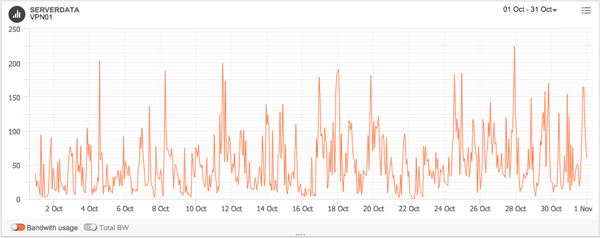
Amount of traffic (GB)
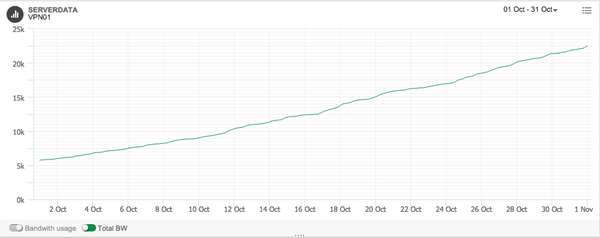
Analysis
VPN01 is the server that has the lowest consumption of all our VPN servers. During October, VPN01 encrypted and anonymized 16705 GB (16,3 TB).
Traffic peaked at 318 Mbps, which is 31% of maximum capacity.
The 95th percentile was only at 132 Mbps, which means that 95 percent of the time, VPN01 was below 12.9% of maximum capacity.
VPN01 had an uptime of 100% during October.
VPN02 - Stockholm
Traffic spikes (Mbit/s)
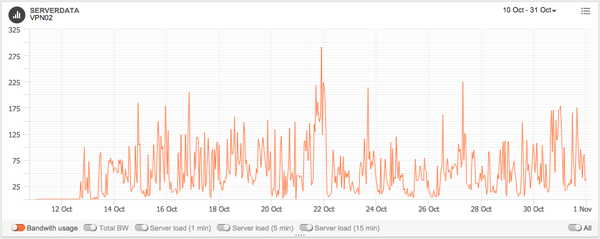
Amount of traffic (GB)
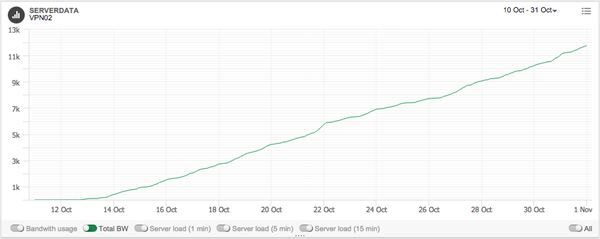
Analysis
VPN02 was put into operation on October 12, when we upgraded our physical safety in Stockholm. During October, VPN02 encrypted and anonymized in total 11751 GB (11,5 TB).
VPN02 is connected at 2x1 Gbit/s, which gives a maximum capacity of 2 Gbit/s. On the other hand, we expect a maximum capacity of 1.4 Gbit/s due to "overhead", and to be on the safe side.
The traffic peak for VPN02 was at 417 Mbit/s, which is 29% of the maximum capacity.
The 95th percentile was at 140 Mbit/s, which means that 95 percent of the time, VPN02 was below 9.8% of maximum capacity.
VPN02 had an uptime of 100% during October.
VPN03 - Stockholm
Traffic spikes (Mbit/s)
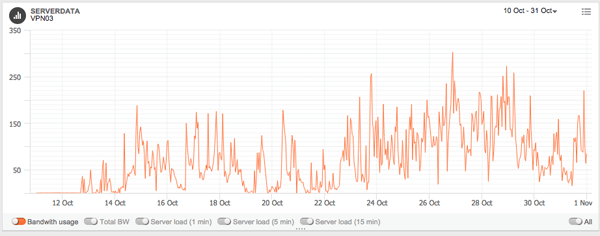
Amount of traffic (GB)
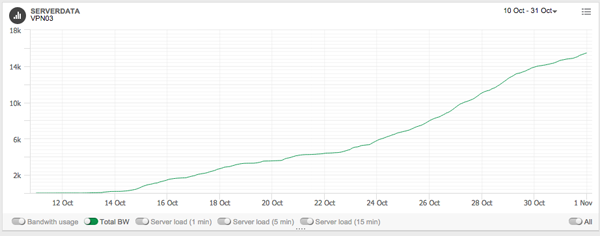
Analys
VPN03 was put into operation on October 12, when we upgraded our physical safety in Stockholm. During October, VPN03 encrypted and anonymized 15445 GB (15,1 TB).
VPN03 is connected at 2x1 Gbit/s, which gives a maximum capacity of 2 Gbit/s. On the other hand, we expect a maximum capacity of 1.4 Gbit/s due to "overhead", and to be on the safe side.
The traffic peak for VPN03 was at 472 Mbit/s, which is 33% of the maximum capacity.
The 95th percentile was at 189 Mbit/s, which means that 95 percent of the time, VPN03 was below 13.1% of maximum capacity.
VPN03 had an uptime of 100% in October.
VPN04 - Stockholm
Traffic spikes (Mbit/s)
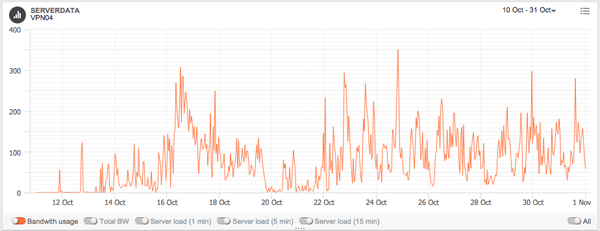
Amount of traffic (GB)
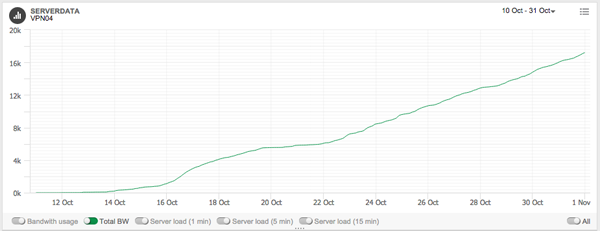
Analysis
VPN04 was put into operation on October 12, when we upgraded our physical safety in Stockholm. During October, VPN04 encrypted and anonymized 17194 GB (16,8 TB).
VPN04 is connected at 2x1 Gbit/s, which gives a maximum capacity of 2 Gbit/s. On the other hand, we expect a maximum capacity of 1.4 Gbit/s due to "overhead", and to be on the safe side.
The traffic peak for VPN04 was at 449 Mbit/s, which is 31% of the maximum capacity.
The 95th percentile was 203 Mbit/s, which means that 95 percent of the time, VPN04 was below 14.2% of maximum capacity.
VPN04 had an uptime of 100% in October.
WEB01 - Falun
Uptime (%)
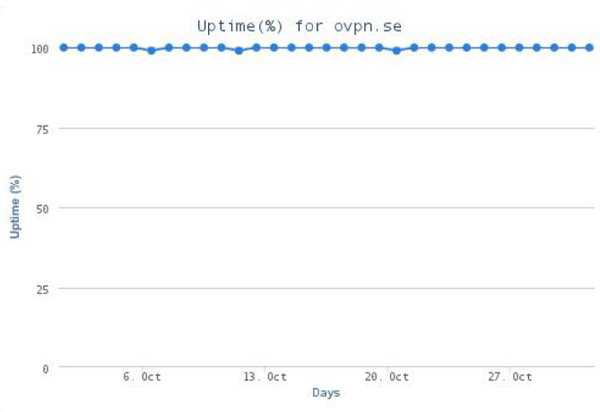
We had some outages with WEB01 during October, but we managed to have an uptime of 99.97% and an average response time of 160ms. The downtime was a total of 13 minutes.
SQL01 - Falun
Uptime (%)
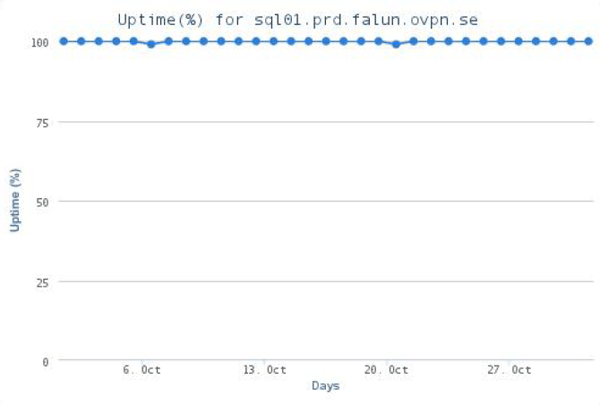
Since SQL01 is on the same server as WEB01, we also had some small downtime with SQL01 during October.
The uptime, however, was better, as we managed to have an uptime of 99.98% which means a downtime of 11 minutes. The latency of SQL01 was an average of 42ms.
SQL02 - Falkenberg
Uptime (%)
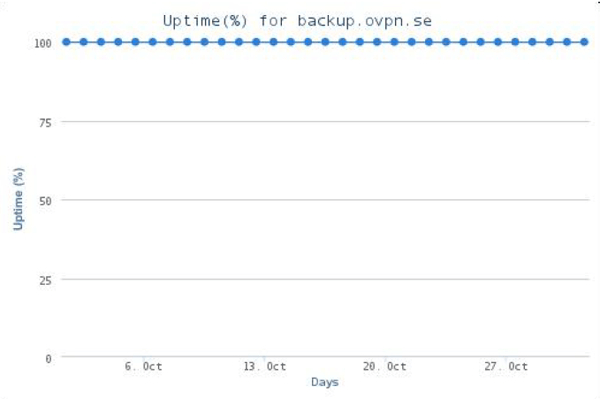
SQL02 had an uptime of 100%, and an average response time of 57 ms.
Summary
We managed without problems to keep an uptime of at least 99.5% during October. It is also clear that we are not currently close to our maximum capacity, which means that we have a lot of room to bring in new customers, but also to ensure high speeds for our current customers.
Measurement of the speed and consumption of the servers is done through the following script, which runs once per minute.
#!/bin/bash
RXPREV=-1
TXPREV=-1
for i in 1 2 3; do
RX=`cat /sys/class/net/eth0/statistics/rx_bytes`
TX=`cat /sys/class/net/eth0/statistics/tx_bytes`
if [ $RXPREV -ne -1 ] ; then
let BWRX=$RX-$RXPREV
let BWTX=$TX-$TXPREV
echo "$BWRX|$BWTX|$RX|$TX"
fi
RXPREV=$RX
TXPREV=$TX
sleep 1
done
So we absolutely save no traffic information on what our customers are doing to compile this report. We only look at how many bytes have gone through the servers.
David Wibergh
